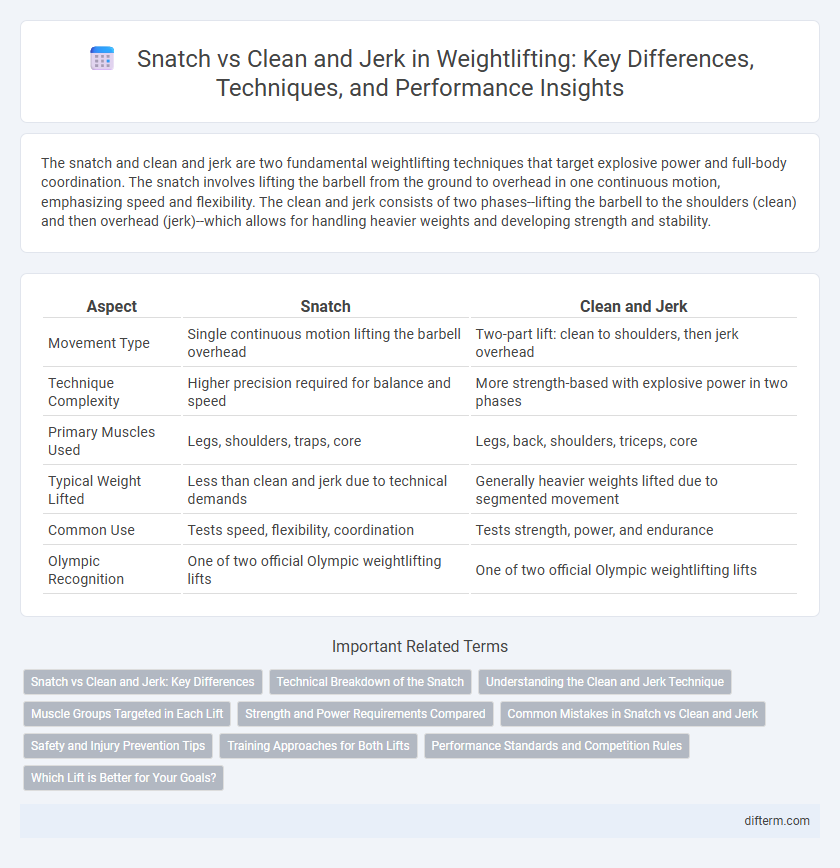The snatch and clean and jerk are two fundamental weightlifting techniques that target explosive power and full-body coordination. The snatch involves lifting the barbell from the ground to overhead in one continuous motion, emphasizing speed and flexibility. The clean and jerk consists of two phases--lifting the barbell to the shoulders (clean) and then overhead (jerk)--which allows for handling heavier weights and developing strength and stability.
Table of Comparison
| Aspect | Snatch | Clean and Jerk |
|---|---|---|
| Movement Type | Single continuous motion lifting the barbell overhead | Two-part lift: clean to shoulders, then jerk overhead |
| Technique Complexity | Higher precision required for balance and speed | More strength-based with explosive power in two phases |
| Primary Muscles Used | Legs, shoulders, traps, core | Legs, back, shoulders, triceps, core |
| Typical Weight Lifted | Less than clean and jerk due to technical demands | Generally heavier weights lifted due to segmented movement |
| Common Use | Tests speed, flexibility, coordination | Tests strength, power, and endurance |
| Olympic Recognition | One of two official Olympic weightlifting lifts | One of two official Olympic weightlifting lifts |
Snatch vs Clean and Jerk: Key Differences
The snatch and clean and jerk are two Olympic weightlifting lifts that differ primarily in technique and muscle engagement. The snatch involves lifting the barbell from the ground to overhead in one continuous motion, emphasizing speed, flexibility, and balance. The clean and jerk comprises two stages--cleaning the barbell to the shoulders and then jerking it overhead--focusing on maximal strength and explosive power.
Technical Breakdown of the Snatch
The snatch requires lifting the barbell from the ground to overhead in one explosive motion, demanding exceptional speed, flexibility, and coordination. Key technical elements include a wide grip, rapid extension of hips and knees, and a deep squat to catch the barbell overhead with arms fully extended. Proper bar path and stable overhead position are crucial to maximize efficiency and minimize injury risk during the snatch lift.
Understanding the Clean and Jerk Technique
The clean and jerk technique in weightlifting involves lifting the barbell from the floor to the shoulders (clean) and then overhead (jerk) in two distinct phases, requiring explosive power and precise coordination. Proper foot positioning during the clean phase maximizes stability, while a strong dip and drive in the jerk phase generate upward momentum to safely lock out the weight overhead. Mastery of bar path, timing, and body alignment enhances performance and reduces injury risk in competitive weightlifting.
Muscle Groups Targeted in Each Lift
The snatch primarily targets the posterior chain, including the glutes, hamstrings, and lower back, while also engaging the shoulders and traps for stability and overhead support. In contrast, the clean and jerk emphasizes quadriceps activation through the clean phase and shoulders, triceps, and core during the jerk phase, delivering a comprehensive full-body workout. Both lifts require explosive power and coordination, but their specific muscle group demands differ significantly.
Strength and Power Requirements Compared
The snatch demands explosive power and exceptional speed to lift the barbell overhead in one continuous motion, emphasizing fast-twitch muscle fiber activation and maximal acceleration. The clean and jerk requires greater overall strength and power, with the clean focusing on a powerful pull to bring the barbell to the shoulders, and the jerk demanding explosive leg drive and upper body force to propel the weight overhead. Both lifts develop maximal strength and power but target slightly different muscle activation patterns and neuromuscular coordination for optimal Olympic weightlifting performance.
Common Mistakes in Snatch vs Clean and Jerk
Common mistakes in the snatch include improper bar path, often pulling the bar too far forward, and inadequate hip extension, which limits power generation. In the clean and jerk, errors frequently involve poor front rack position and timing issues during the jerk drive, reducing stability and lift efficiency. Both lifts demand precise technique and strong coordination to avoid injury and maximize performance.
Safety and Injury Prevention Tips
The snatch and clean and jerk demand precise technique to minimize injury risks, with the snatch requiring a wider grip and rapid overhead stabilization that stress the shoulders and lower back. Athletes should prioritize proper warm-up, mobility drills, and progressive loading to enhance joint stability and avoid common injuries such as rotator cuff strains and lumbar sprains. Using supportive equipment like weightlifting belts and wrist wraps, alongside structured coaching feedback, significantly contributes to safe execution and long-term musculoskeletal health.
Training Approaches for Both Lifts
Training for the snatch emphasizes explosive speed, flexibility, and precise technique to lift the barbell swiftly overhead in one smooth motion. Clean and jerk training prioritizes building raw strength, power, and stability to manage the two distinct phases--the clean and the jerk--under heavy loads. Athletes often incorporate targeted mobility drills, plyometrics, and varied grip work to optimize performance and prevent injury across both lifts.
Performance Standards and Competition Rules
The snatch and clean and jerk are two Olympic weightlifting movements with distinct performance standards and competition rules governed by the International Weightlifting Federation (IWF). In the snatch, athletes lift the barbell from the floor to overhead in one continuous motion, while the clean and jerk involves two stages: lifting the barbell to the shoulders (clean) and then overhead (jerk). Competition rules enforce strict criteria for lift validity, including locked elbows, no pressing out during the jerk, and controlled position stabilization; successful lifts must follow these standards to be scored officially.
Which Lift is Better for Your Goals?
The snatch emphasizes speed, flexibility, and full-body coordination, making it ideal for athletes aiming to improve explosive power and mobility. The clean and jerk allows for heavier weights to be lifted, targeting maximal strength and power output, which benefits those focused on muscle growth and overall strength development. Your choice depends on whether your goal is to enhance speed and technique or to build raw strength and power in weightlifting performance.
snatch vs clean and jerk (weightlifting) Infographic

 difterm.com
difterm.com